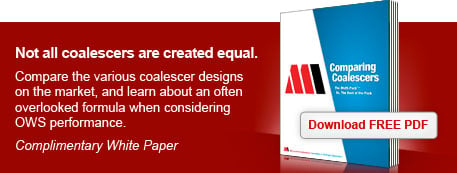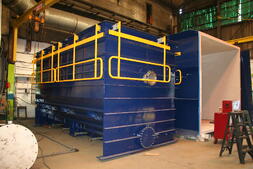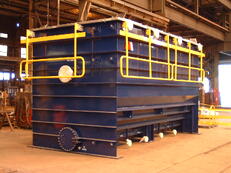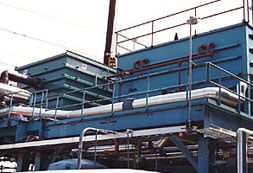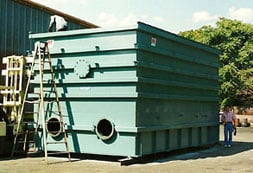 Above Ground Oil Water Separators 750 gpm - 1000 gpm
Above Ground Oil Water Separators 750 gpm - 1000 gpm
Problems We've Solved:
As the flow rates become larger, the importance of dedicated settling (solids) and rising (oil) zones become critical for a non-fouling design. Not only do the Chimney Zones™ process oils and solids out of the coalescer, they naturally create a break in the coalescer plate, providing shorter plate widths in the flow direction. Shorter plate widths yield a low "equivalent diameter" which is a measure of how a coalescer plate configuration will perform with solids present. In a large separator with a standard-type coalescer, a solids particle entering the coalescer, say at the upper left-hand portion of the coalescer in the entry area view, will have to slide down a coalescer plate for up to 6-10 feet (or even more). It continues along until it exits the plate pack at some lower left portion of the coalescer where it is to be processed out of the coalescer (theoretically). With a plate length that long, and the nooks and crannies in most typical coalescer designs, the likelihood of fouling increases dramatically. Our short plate-width design reduces the fouling problems significantly.
Multi-Pack Fact:
Inlet/Outlet Distribution Baffles - Mercer is one of the very few separator manufacturers that continues to provide two-stage distribution baffles. Our two-stage distribution baffle system is designed to assure evenly dispersed flow over the entire entry area of the coalescer--offering superior results within the coalescer.
Flow enters a distinct inlet section, in the front end of the separator, designed to break up the velocity of the inlet flow entering the separator. This is especially important when the influent is pumped into the unit. Once the energy and velocity of the inlet flow has been reduced, the flow then enters the first stage of the flow distribution plates. Careful control of the velocity through the first stage baffle assures even flow distribution through all areas of the baffle, helping to ensure even flow over the entire entry area of the coalescer. Equalized flow velocity entering the coalescer is critical in achieving efficiencies that approach the design potential of the coalescer per Stoke's Law.
The second stage of the inlet flow distribution baffle system further distributes flow and is designed for efficient eddy current reduction. Momentum and kinetic energy are further dissipated through this second stage. This efficient flow distribution and eddy current reduction design further enhances operational efficiencies, thereby offering significantly better results in the field.
Without an efficient flow distribution system in place, inlet flow enters the coalecer unevenly. The inlet end of the coalescer then, by default, acts as the flow distribution system taking away from the actual usable plate surface area for optimal separation.
The vast majority of separator designs typically have only a 90° or 45° elbow, tee or an angled plate as a velocity diffusion system. At best this is a poor flow distribution system and puts undue "strain" on the coalescer—causing unnecessary inefficiencies in the coalescer section (where the most critical separation is occurring).
Our distribution baffles are also easily removable without entering or emptying the separator. Mercer is the only major manufacturer offering a removable two-stage distribution baffles.
Mercer is one of the very few that continues to supply an outlet flow distribution baffle, as well (what is good for inlet distribution is also good for distribution). The outlet distribution baffle is a single-stage, perforated baffle placed after the coalescer and works in combination with the inlet distribution baffle. The outlet distribution baffle helps maintain uniform flow throughout the separator, and prevents “coning” (short-circuiting of the upper portion of the coalescer). With efficient flow distribution baffles on both the inlet and outlet section, unused areas of the coalescer are virtually eliminated.
Mercer also supplies a well-designed adjustable weir plate with attention to details. What makes our weir unique besides our inherently corrosion resistant materials and hardware is the fact that we put the bolts so close together that one can literally tighten the hardware nuts by hand to hydraulically seal the weir system. This design prevents the deformation of the gasket. By keeping the gasket in its original unmarred state, the weir plate can be easily adjusted to different heights without the weir plate leaking due to a deformed gasket. Mercer also employs ergonomically adjustment handles on each side of our larger weir plates for ease of operation use.

